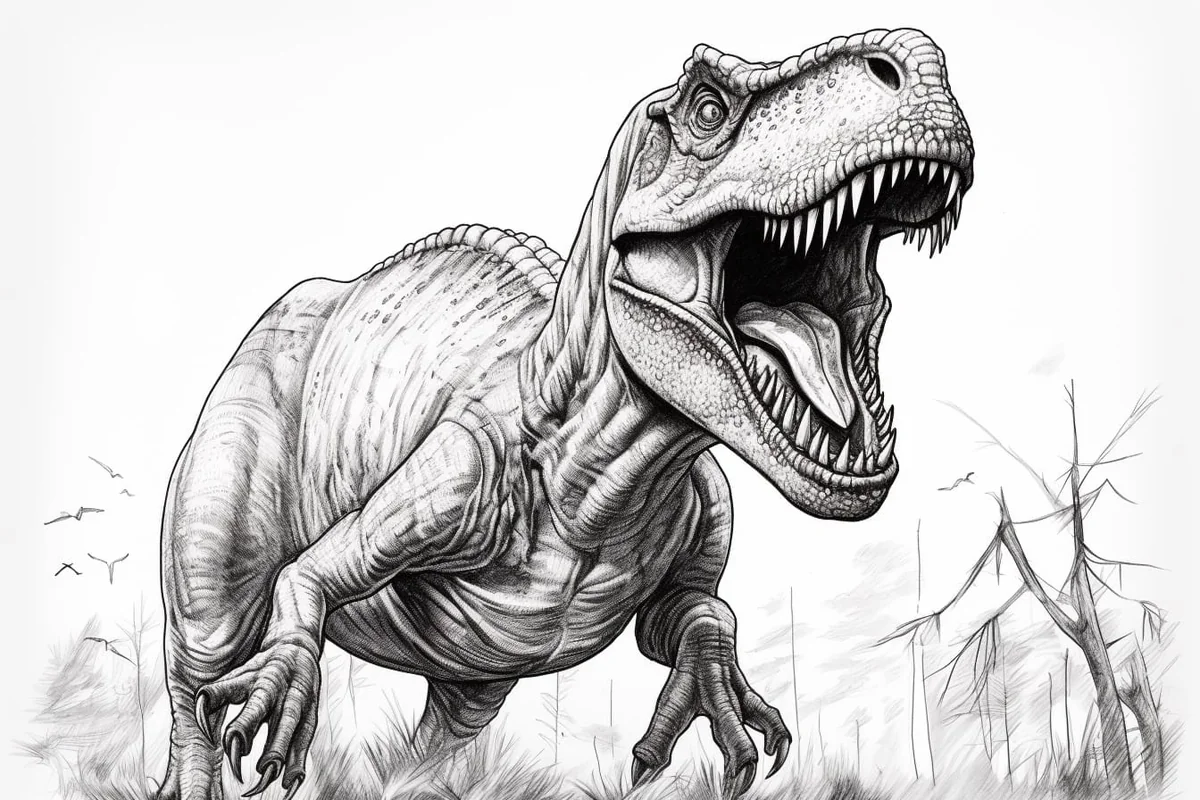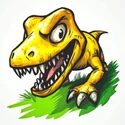How to Draw an Allosaurus in 10 Simple Steps
Learn how to draw an Allosaurus with this step-by-step guide. Discover techniques to sketch the prehistoric dinosaur's powerful body and distinctive features to

Materials You'll Need
- Drawing paper
- Pencil (HB or 2B)
- Eraser
- Colored pencils
- Markers
- Blending stump

Welcome to the world of paleoart, where we bring prehistoric creatures to life through our sketches and drawings. Today, we will be diving into the mesmerizing world of the Allosaurus, one of the most iconic and fearsome dinosaurs that roamed the Earth during the Late Jurassic period.
Learning how to draw an Allosaurus is a thrilling challenge that allows us to explore its powerful presence, sharp teeth, and formidable stature. Through careful observation and attention to detail, we can capture the essence of this apex predator and create a stunning portrait that pays homage to its ancient legacy.
Join me as we embark on a journey back in time to unleash our artistic skills and breathe life into the magnificent Allosaurus through the strokes of our pencils and pens. Let's sharpen our pencils, unleash our creativity, and embark on this artistic adventure together!
Materials Required
To draw an Allosaurus, you will need the following materials:
-
Pencil
-
Eraser
-
Fine-tip black pen or marker (optional for outlining)
-
Colored pencils, markers, or crayons for coloring (optional)
-
Reference images of Allosaurus for inspiration and accuracy
These basic materials should be sufficient for creating a drawing of an Allosaurus. Feel free to add any other materials you prefer or experiment with different mediums to enhance your artwork.
How to Draw an Allosaurus: a Step-by-step Guide
Step 1: Gather Your Materials
Gather all the necessary materials for the drawing, including a pencil, eraser, drawing paper, and reference images of an Allosaurus for guidance.
Step 2: Start with Basic Shapes
Begin by lightly sketching the basic shapes of the Allosaurus. Start with an oval for the head, a larger oval for the body, and smaller ovals for the limbs.
Step 3: Refine the Body Shape
Add more details to the body shape by adding curves and contours to define the muscle structure and overall form of the Allosaurus.
Step 4: Sketch the Head and Jaw
Focus on the head of the Allosaurus. Sketch the shape of the skull, including the prominent eye sockets and snout. Add the jawline and teeth for a fearsome look.
Step 5: Add Limbs and Tail
Extend the ovals for the limbs to create the arms and legs of the Allosaurus. Pay attention to the muscle definition and positioning of the limbs. Then, sketch the long tail extending from the body.
Step 6: Refine Details
Add more details to the Allosaurus, such as scales, claws, and other distinctive features. Pay close attention to the texture of the skin and the overall appearance of the dinosaur.
Step 7: Erase Guidelines
Once you are satisfied with the overall shape and details of the Allosaurus, go over your drawing and erase any remaining guidelines and rough sketches to clean up the final artwork.
Step 8: Add Shadows and Highlights
To give your Allosaurus drawing more depth and dimension, add shading to create shadows and highlights. Pay attention to the light source to determine where the shadows fall on the dinosaur's body.
Step 9: Final Touches
Add any final touches or details to enhance the realism of your Allosaurus drawing. Take your time to make any necessary adjustments and ensure that the drawing looks polished and complete.
Step 10: Sign and Date Your Artwork
Finally, sign and date your Allosaurus drawing to mark it as your own creation. You can also consider adding a background or framing the artwork to display it proudly.
Tip: When drawing your Allosaurus, focus on building a strong foundation with basic shapes before adding details. Start with a large oval for the body, a smaller circle for the head, and simple lines for the limbs and tail. Use a light pencil to sketch these shapes, as they will serve as your guide. This approach allows you to easily adjust proportions and angles without the pressure of getting it perfect on the first try. Once you're satisfied with the overall layout, begin refining the shapes into more defined features, paying close attention to the unique characteristics of the Allosaurus, like its powerful jaws and distinctive posture. Don't forget to refer to reference images for accuracy and inspiration!
Conclusion
In conclusion, drawing an Allosaurus can be a rewarding and enjoyable experience that allows artists to explore the fascinating world of prehistoric creatures. Following the step-by-step guide in this article and practicing your observational skills, you can create a dynamic and realistic representation of this fearsome predator. Remember to be patient with yourself, embrace mistakes as learning opportunities, and, most importantly, have fun expressing your creativity through drawing. With dedication and practice, you can continue to hone your skills and bring these ancient creatures to life on paper.
Fun Facts About Allosauruses
-
Allosauruses were large theropod dinosaurs that lived during the Late Jurassic period, around 155 to 150 million years ago.
-
They were one of the largest carnivorous dinosaurs of their time, measuring up to 39 feet (12 meters) in length and weighing around 2,200 to 4,400 pounds (1,000 to 2,000 kilograms).
-
Allosauruses had a unique skull structure with large, sharp teeth and powerful jaws, making them efficient predators capable of taking down large herbivorous dinosaurs like Stegosaurus and Diplodocus.
-
Evidence suggests that Allosauruses may have been social creatures, hunting in packs or at least tolerating the presence of other individuals in their territory.
-
They were agile and fast-moving dinosaurs, with long legs and a relatively lightweight build compared to other large theropods like Tyrannosaurus rex.
-
Allosauruses likely had a keen sense of smell and sharp vision, helping them locate prey and navigate their environment efficiently.
-
Fossil evidence indicates that Allosauruses may have engaged in cannibalism, with some specimens showing bite marks and fractures consistent with attacks from other Allosauruses.
-
The name "Allosaurus" means "different lizard" in Greek, referring to the unique characteristics of this dinosaur compared to other known species at the time of its discovery.
-
Allosauruses were widespread across North America, Europe, and possibly other regions, indicating their success as a dominant predator during the Late Jurassic period.
-
Despite their fearsome reputation, Allosauruses were not the top predators of their time, as they shared their environment with other formidable carnivorous dinosaurs like Ceratosaurus and Torvosaurus.
Suggestions for Scenes and Settings for Allosaurus Drawings
Absolutely! Here are some specific suggestions for scenes and settings to draw Allosaurus in:
-
Prehistoric Forest: Create a lush, dense forest setting with towering ferns, moss-covered trees, and a meandering river in the background. Place the Allosaurus in a stalking pose, blending in with the greenery as it hunts for prey.
-
Volcanic Landscape: Imagine a rugged, rocky terrain with a smoking volcano in the distance. Place the Allosaurus in the foreground, its sharp teeth bared, as it navigates the treacherous landscape in search of food.
-
Dinosaur Nest: Draw a scene where an Allosaurus is guarding its nest filled with eggs. Add details like broken eggshells, protective parents, and a sense of tension as other predators lurk nearby.
-
Dusk Hunt: Set the scene during the twilight hours, with the sky painted in hues of orange and purple. Illustrate the Allosaurus on the prowl, its silhouette against the fading light as it prepares to strike.
-
Underwater Hunt: Get creative with a scene set underwater, showcasing the Allosaurus in a river or shallow sea environment. Include details like aquatic plants, marine life, and the dinosaur swimming gracefully or hunting for fish.
-
Cliffside Encounter: Picture the Allosaurus perched on a rugged cliff edge, overlooking a vast canyon below. Capture the tension and drama of the moment as the dinosaur surveys its surroundings, ready to defend its territory.
-
Ice Age Setting: Transport the Allosaurus to a frozen tundra landscape, complete with icy caves, snow-covered mountains, and woolly mammoths roaming in the distance. Show the dinosaur adapting to the harsh conditions in search of food.
-
Jurassic Ruins: Create a scene where the Allosaurus explores ancient ruins or abandoned temples from the Jurassic era. Add a sense of mystery and discovery as the dinosaur navigates the overgrown structures, hinting at a lost civilization.
Feel free to mix and match these suggestions or come up with your own unique ideas to bring your Allosaurus drawings to life!